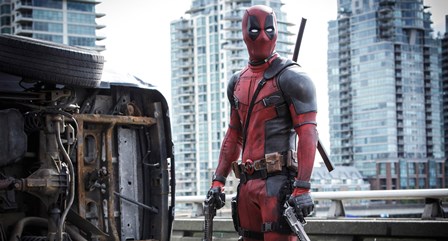Deadpool.
Deadpool, one of the biggest hits of the year so far, was finished on Baselight by colourist Tim Stipan at Deluxe’s EFILM facility in Hollywood.
“Working on such a complex, effects-heavy project often requires various external matte sequences in addition to multiple image tracks", Stipan said.
"Multiply that by the large number of VFX vendors, and it meant we had a lot of different layers and mattes".
During Deadpool’s production in Vancouver, Stipan and DoP Ken Seng (an old university friend) ran camera and lens tests, then devised a set of reference looks on-set, much of which could be created in camera to build a natural look.
They also tested different film grains that were used for some of the versions of the movie, with the exception of HDR, IMAX and Dolby Vision.
“We were going for a gritty look. We didn’t want a very saturated, bright, warm superhero movie. We wanted it to feel much darker, colder”, Stipan said.
“The director Tim Miller is also an animator and VFX artist and was orchestrating the movie visually. He worked closely with us on the colour process.”
Part of the grading challenge was to match live footage consistently across the scenes. Much of the film was shot in Vancouver, largely on ARRI Alexa cameras.
One key sequence, a battle on a bridge, took 12 days to shoot, during which time the Vancouver weather was inconveniently changeable.
Stipan used Baselight to isolate Deadpool’s suit, and give the main character a dark, modern touch.
Director Miller wanted a particular vibrancy and substance for the CGI character Colossus, so Stipan had mattes that allowed him to create the right look for his clothes and body using multiple alpha channels.
One particular Baselight feature that Stipan found invaluable on this project was the ability to see and compare multiple versions.
“I could put Baselight in stereo mode and see the cinema version and the HDR version at the same time – one eye on the projector and the other on the monitor", he said.
"This was really useful and helped to make sure I was matching what I did for cinema across all the deliverables. I’ve never seen that in any grading system before – I’ve always dreamt of doing it.”
The movie was delivered in a number of formats, and while most of the VFX was in 2K the movie was finished in 4K, not least because of the need for an IMAX version.
While all the core grading was done on the Fox lot in LA, for some of the deliverables Stipan moved across town to Company 3.
“They have a theatre with a Dolby projector, so we went over there for a couple of days to do the Dolby Vision version. Everything else was done at EFILM.”
“It was a challenge to finish the movie in time because there was so much VFX work,” Stipan concluded. “But the director was really impressed with the way Baselight helped to bring it all together and indeed with what we could do with the system itself.”


